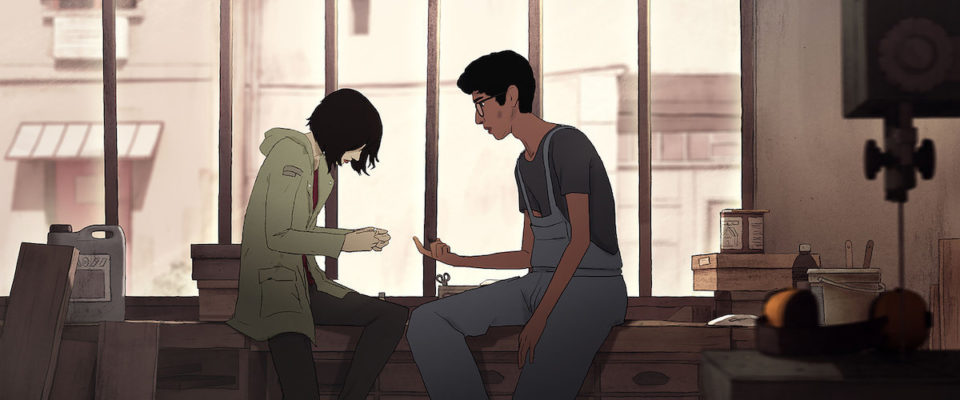I Lost My Body (in French, J’ai perdu mon corps) tackles issues of love, loss and maturity, all through a series of flashbacks in the protagonist’s (Naofel) life. But what one doesn’t expect is that these memories are brought to the fore by tracing the journey of Naofel’s severed hand as it tries to find its way back to him. Based on Guillaume Laurant’s (writer for Amélie – 2001) Happy Hand, Jérémy Clapin spins a touching tale as we follow a hand traversing the banlieues of Paris in the 90s.
The movie begins quite suddenly with Naofel (Hakim Faris) lying on the floor, battered and bruised, with his severed hand by his side. With a quick glimpse into his blissful childhood in Morocco, we find ourselves in a laboratory, surrounded by body parts, and so, the story commences from the perspective of the hand. The hand escapes the wretched laboratory and attempts to locate its body in the bustling city of Paris. In doing so, it recalls moments in Naofel’s life, all the way from his childhood and leading up to his ‘accident’.
A key event which dramatically changes Naofel’s life and scars him for years to come, is the death of his parents in a car crash. Upon their death, he moves to Paris to live with his uncle and cousin, who are very different from his loving parents. This new mode of upbringing eventually manifests as an overly pessimistic worldview when Naofel becomes an adult. One day, while out on his job, he meets Gabrielle (Victoire Du Bois) under very unique circumstances and his life begins to look up. So what goes wrong? What happens to his hand? This is only revealed as the film unfolds.
One can easily see that eight years were spent producing this masterpiece. One is surprised by how one can sympathise with a face-less, expressionless being, i.e a severed hand. However, the careful and calculated movements by the hand render it almost anthropomorphic. It is scared of being caught, it is delighted at the sight of a baby and most of all, it is determined to return ‘home’ (in other words, to rejoin Naofel’s body). The shifts between the two storylines are so seamless that they forcefully demonstrate the importance of the hand in Naofel’s life, and therefore, the importance of a hand in any human life. Trivial experiences such as playing with sand on the beach or trying to catch a fly are given a new meaning. The film is a sensory experience, both in terms of touch but also in terms of sound, especially as is embodied through the recurring use of Naofel’s tape recorder.
Most filmmakers choose to show the rosier side of Paris but I Lost My Body sheds light on the grittier side of the city of lights, the banlieues, where most immigrant and low income families live. During one conversation between Naofel and Gabrielle, they ponder over the sound of rain and how those on higher floors cannot hear the rain splattering on the ground and so are removed from reality. This, in my opinion, represents class difference in Paris and shows how those in ‘posher’ parts of Paris are removed from the harsh reality of life. The honesty involved in selecting these poorer areas as the focus for a film makes I Lost My Body a breath of fresh air. Moreover, the choice to have a Moroccon immigrant as the main character is also a very surprising, but welcome, move from a filmmaker, one that widens the representation of Paris’ multicultural community.
The music, by Dan Levy, matches the melancholic (and unsettling) undertones of the film and greatly complements certain scenes, such as those from Naofel’s childhood, making them unbearably bittersweet for the viewer as we come to learn the fate of Naofel’s parents. There is a rap song too that works well with the environment of the banlieue and really draws the viewer into an alternate conception of Paris as a society bursting with many art forms besides the sculptures and paintings we associate with the Louvre.
The animation style is also noteworthy; the film CGI animated but has a ‘rough’, sketch-like feel to it that Clapin has noted he was especially keen to include. According to his interview in Deadline Magazine, he wanted the characters to come alive but also wanted to show the human aspect and the amount of work put into the film. This results in the beautifully imperfect animation we find in viewing I Lost My Body.
Needless to say, I Lost My Body is one of the finest animated films I’ve ever seen, putting it high up in the ranks with Loving Vincent and Princess Kaguya (animated gems, which I’d also recommend you watch!). It is no wonder that this film was the first animated feature to win the Nespresso Grand Prize at the Cannes Film Festival last year or that it was nominated for Best Animated Feature at the 92nd Academy Awards. Clapin does the impossible by placing a severed hand at the centre of a film while still managing to unpack Naofel’s struggle to overcome his demons, and the film is well worth a watch.
I Lost My Body is available to stream on Netflix in multiple languages.



